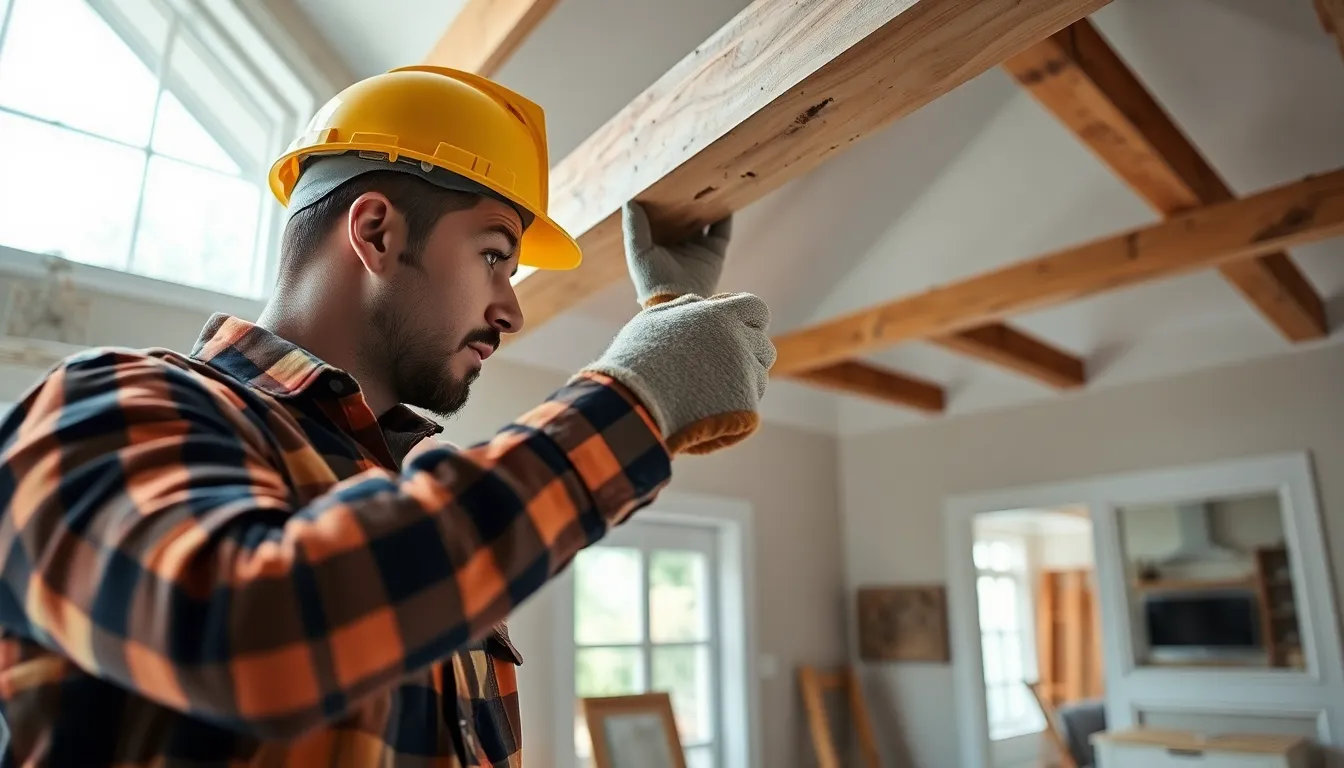When disaster strikes and a leaky roof or a broken pipe makes a surprise appearance, understanding property repair timelines can feel like trying to solve a Rubik’s Cube blindfolded. Homeowners often find themselves caught in a whirlwind of confusion, wondering how long it’ll take to get their cozy abode back in tip-top shape. Spoiler alert: it’s not always as quick as a click on a home improvement app.
Table of Contents
ToggleUnderstanding Property Repair Timelines
Property repair timelines play a crucial role in managing expectations during restoration processes. Understanding these timelines helps homeowners navigate complexities throughout repairs.
Importance of Timelines in Property Repair
Timelines provide clarity about when to expect completion of repairs. They help homeowners plan living arrangements and budget for unexpected costs. Accurate timelines also facilitate communication with contractors, ensuring everyone remains on the same page. Timelines create a sense of urgency for professionals to prioritize tasks, promoting timely completion. By adhering to established timelines, homeowners can mitigate stress and reduce frustration associated with prolonged repairs.
Common Factors Affecting Timelines
Numerous factors can extend property repair timelines. Weather conditions pose significant challenges, especially for outdoor repairs. Availability of materials often impacts the speed at which work can proceed. Labor shortages in the area can also result in delays, as finding skilled workers may take time. Inspection requirements sometimes lead to unexpected wait times, particularly when building codes must be met. Communication issues between parties can cause misunderstandings, further prolonging the process.
Types of Property Repairs

Property repairs typically fall into three key categories: cosmetic, structural, and emergency. Understanding these types helps homeowners manage repair expectations and timelines.
Cosmetic Repairs
Cosmetic repairs improve a property’s aesthetic appeal. Common tasks include painting walls, updating fixtures, or replacing flooring. These updates typically require minimal time, often ranging from a few days to a couple of weeks for completion. Factors such as the size of the area and material choices can affect timing. Budget-friendly options allow some homeowners to complete these tasks independently. However, hiring a professional can guarantee higher quality outcomes.
Structural Repairs
Structural repairs address essential components that ensure safety and stability. Examples include fixing a leaky roof, reinforcing foundations, or repairing framing issues. These repairs often demand more extensive expertise, taking several weeks or even months, depending on the project’s complexity. Material availability and labor shortages can further extend timelines. Homeowners must engage qualified contractors to navigate permits and inspections, ensuring adherence to building codes and safety standards.
Emergency Repairs
Emergency repairs involve urgent issues requiring immediate attention. Burst pipes, electrical failures, or severe roof leaks exemplify typical emergencies. These situations demand quick action, often initiated within hours of identification. While some repairs can be temporarily patched, permanent solutions usually follow. Timelines for emergency repairs can vary; some issues resolve within days, while others may take weeks to fully address. Homeowners benefit from establishing relationships with reliable emergency service providers, ensuring prompt responses during crises.
Estimating Repair Timelines
Estimating repair timelines involves evaluating damage and obtaining quotes from contractors. Understanding these steps ensures a smoother recovery process.
Assessing Damage
Evaluating the extent of damage sets the foundation for an accurate timeline. Homeowners must inspect the affected areas thoroughly. Documenting visible issues aids communication with contractors. Photographs help illustrate concerns, while detailed notes provide clarity. Immediate assessments prioritize urgent repairs, especially if structural integrity is compromised. Working with professionals can expedite evaluations, leading to quicker decision-making. Repair timelines hinge on the severity of damage; minor issues may take a few days, whereas significant repairs could extend several weeks.
Getting Quotes from Contractors
Gathering quotes from multiple contractors ensures competitive pricing and reliable timelines. Homeowners should seek detailed estimates that outline labor and material costs. Requesting a timeline for each quote helps compare repair duration alongside pricing. Engaging local professionals familiar with the area enhances scheduling predictability. Contracting experienced specialists often streamlines project management, reducing unexpected delays. Communication abilities also play a vital role; responsive contractors can accommodate changes and provide updates. Timelines for quotes may vary, with some contractors available for immediate assessments while others take several days to respond.
Managing Expectations
Managing expectations during property repairs is essential for a smooth restoration process. Homeowners can minimize frustration by understanding timelines and communicating effectively.
Communicating with Contractors
Contractors appreciate clear communication from homeowners. Discussing project details helps contractors set accurate timelines and budgets. Frequent updates on progress keep everyone informed and address potential issues promptly. Establishing a point of contact streamlines communication, allowing for quick responses to questions or concerns. Sharing specific preferences and deadlines enables contractors to prioritize tasks according to the homeowner’s needs. Building this rapport eases the coordination of schedules and enhances the overall repair experience.
Setting Realistic Deadlines
Setting realistic deadlines requires careful consideration of various factors. Homeowners benefit from outlining specific needs while factoring in potential delays. Assessing the scope of work guides expectations around completion times. Construction timelines might differ based on labor availability, seasonal weather conditions, and material procurement. Professional contractors often provide insight into typical timelines for different types of repairs. Knowing these timeframes assists homeowners in planning effectively and ensuring necessary arrangements during the repair process.
Understanding property repair timelines is essential for homeowners navigating unexpected repairs. By grasping the complexities involved in different types of repairs homeowners can better manage their expectations and minimize stress. Establishing clear communication with contractors is vital for ensuring timely updates and accurate timelines.
With a proactive approach to planning and budgeting homeowners can navigate the repair process more smoothly. Building relationships with reliable service providers also plays a key role in achieving prompt responses during emergencies. Ultimately being informed and prepared can make all the difference when it comes to restoring a home efficiently.



